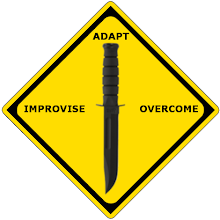WOUNDS
An interruption of the skin’s integrity characterizes wounds. These wounds could be open wounds, skin diseases, frostbite, trench foot, or burns.
OPEN WOUNDS
Open wounds are serious in a survival situation, not only because of tissue damage and blood loss, but also because they may become infected. Bacteria on the object that made the wound, on the individual’s skin and clothing, or on other foreign material or dirt that touches the wound may cause infection. By taking proper care of the wound you can reduce further contamination and promote healing. Clean the wound as soon as possible after it occurs by—
- Removing or cutting clothing away from the wound.
- Always looking for an exit wound if a sharp object, gunshot, or projectile caused a wound.
- Thoroughly cleaning the skin around the wound.
- Rinsing (not scrubbing) the wound with large amounts of water under pressure. You can use fresh urine if water is not available.
Cover the wound with a clean dressing. Place a bandage on the dressing to hold it in place. Change the dressing daily to check for infection.If a wound is gaping, you can bring the edges together with adhesive tape cut in the form of a “butterfly” or "dumbbell" (See Figure Below).
Use this method with extreme caution in the absence of antibiotics. You must always allow for proper drainage of the wound to avoid infection.

In a survival situation, some degree of wound infection is almost inevitable. Pain, swelling, and redness around the wound, increased temperature, and pus in the wound or on the dressing indicate infection is present. If the wound becomes infected, you should treat as follows:
- Place a warm, moist compress directly on the infected wound.
- Change the compress when it cools, keeping a warm compress on the wound for a total of 30 minutes.
- Apply the compresses three or four times daily.
- Drain the wound.
- Open and gently probe the infected wound with a sterile instrument.
- Dress and bandage the wound.
- Drink a lot of water.
- In the event of gunshot or other serious wounds, it may be better to rinse the wound out vigorously every day with the cleanest water available.
- If drinking water or methods to purify drinking water are limited, do not use your drinking water.
- Flush the wound forcefully daily until the wound is healed over. Your scar may be larger but your chances of infection are greatly reduced.
- Continue this treatment daily until all signs of infection have disappeared.
- Expose the wound to flies for one day and then cover it.
- Check daily for maggots.
- Once maggots develop, keep wound covered but check daily.
- Remove all maggots when they have cleaned out all dead tissue and before they start on healthy tissue.
- Increasedpain and bright red blood in the wound indicate that the maggots have reached healthy tissue.
- Flush the wound repeatedly with sterile water or fresh urine to remove the maggots.
- Check the wound every 4 hours for several days to ensure all maggots have been removed.
- Bandage the wound and treat it as any other wound. It should heal normally.
Labels: First Aid, Survival, Survival Medicine, Survival Skills


 Subscribe
Subscribe